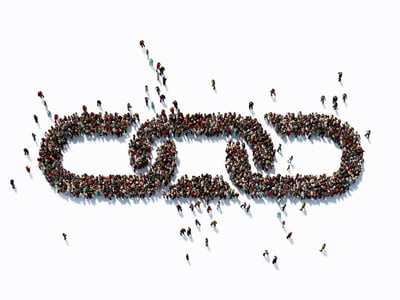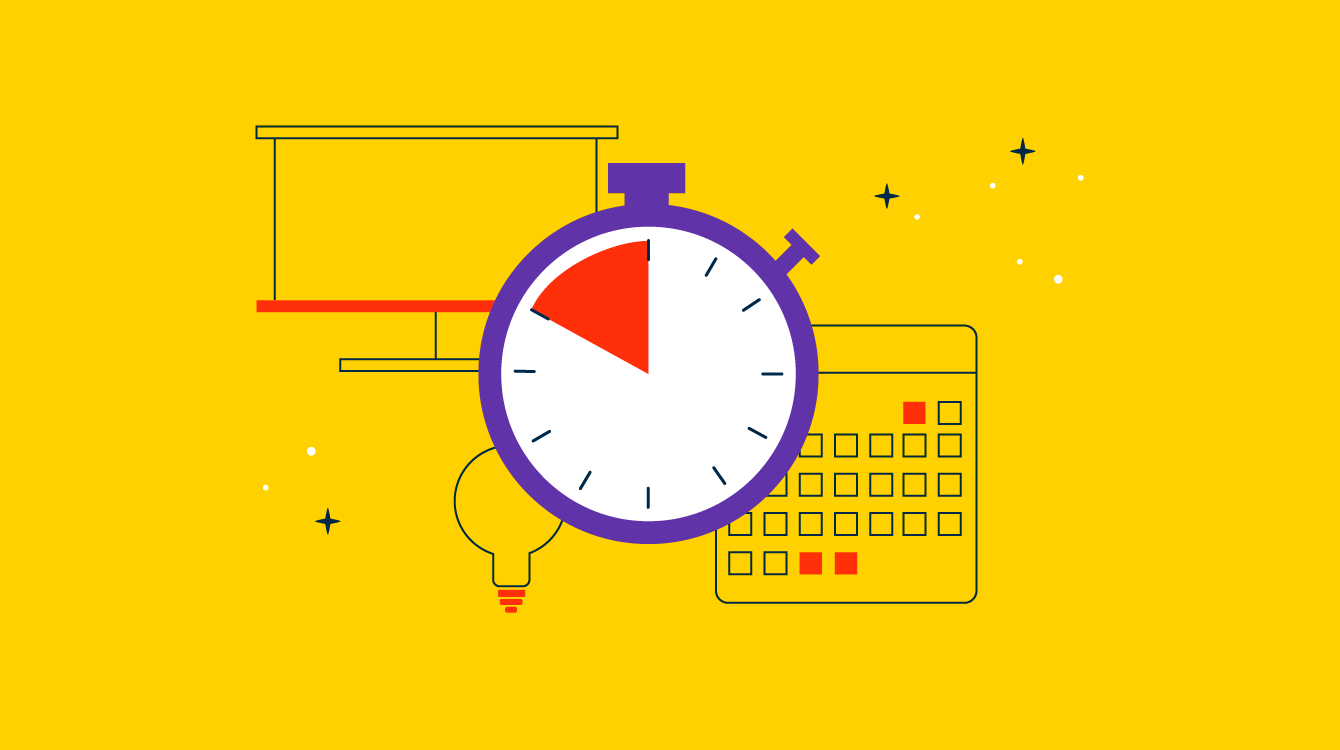

Oh no, I am late for the meeting. Again.
These words may resound in your ears as they come out of your mouth quite often. Being late has habituated our daily lives, so much so that we don't even flicker an eye while continuously making excuses. Why does it happen? Due to lack of poor time management.
A clear timeline roadmap of your upcoming tasks and projects with time tracking software can help you mitigate workload without compromising on productivity.
Time management refers to the practice of prioritizing tasks based on their time requirements. This technique is useful for workers and professionals who want to submit project deliverables, set meetings, plan agendas, and increase their productivity. It helps you allocate time slots for all tasks based on their sense of urgency.
People often mistake time management for meticulous minute-by-minute planning. That’s not what this article is about. Instead of becoming hyper-focused on optimizing every moment of your life, the goal is to find a schedule that works best for you.
Time management is important for several reasons. Often, time management issues stem from more complicated problems. Procrastination, task prioritization, and focus all converge to create roadblocks to staying on task.
Time management doesn’t discriminate between your personal and professional life; it encompasses everything you do with your day. It’s not about forcing more time into your day – it’s about holistically making the most of the time you already have.
If you’re not a morning person now, you’re certainly not going to start waking up at 5 a.m. to go to the gym. Time management works within your schedule and with your goals to create the best version of your day-to-day.
The practice of a time management technique should foster positivity and productivity in your work schedule. By complying with these techniques, your work plate should be tolerable and you should be able to spare time for personal interests as well.
Many professionals nowadays follow online time management techniques, listed as follows.
Everyone from a stay-at-home parent to a project manager uses time management. Time doesn’t discriminate, and everyone can afford to use their time better.
Whether your day-to-day includes going to school or jet-setting around the world for business, we all only have 24-hours in the day. Even people like Beyoncé have a limited amount of time each day to accomplish their goals (and sell over 118 million records, just saying!)
The longer you wait to create better strategies for managing your time the harder it will be to break those habits later on.
You might be asking yourself, how can I tell if I have a time management problem?
That’s a fair question! Most people don’t realize they have a time management problem at first. The thing to remember is that time management problems often disguise themselves as other problems. If you have issues focusing at work or you consistently miss deadlines, you might have a problem with managing your time.

Even if you don’t identify with any of the problems above, you could likely be managing your time better. You don’t have to be floundering to adopt better time management strategies. The work of time management is never truly done. There’s always something you can plan better or work on improving.
Time management is such a popular concept that it has produced many specific methodologies over the years. While some have come and gone, there are three popular ones that many consider the ”Holy Trinity” of time management.
The Eisenhower Decision Matrix, more commonly known as the 4 Ds of time management, can be broken down into four simple components: do, defer, delegate, and delete. This method revolves around the idea that everything you spend your time doing falls into two main categories: urgent/not urgent and important/unimportant.
Under the Eisenhower method, tasks that are considered important and urgent should be at the top of your to-do list while tasks that are neither urgent nor important can probably be done away with altogether.
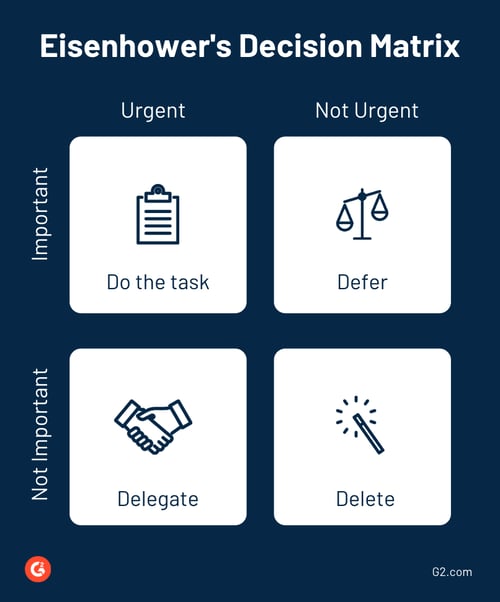
That table might seem a bit confusing but in reality, it’s simple.
Once you understand how to categorize your tasks using the Eisenhower Matrix, you can decide how to schedule your day. The most important and urgent tasks can be completed first while the least urgent and important can be left for later if you have time.
The Pareto principle, also known as the 80/20 rule, was crafted with the idea that 80% of your results come from 20% of your efforts. This method focuses on the 20% of efforts that impact the largest portion of your outcomes. It’s about taking a full assessment of your workflows and creating maximum efficiencies by going all in on your best assets.
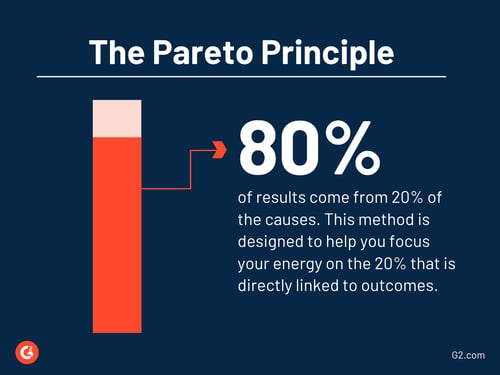
Let’s say you have a website and want to optimize your content to boost organic website visits. The Pareto principle suggests you find the articles driving the most visits to your website and focus on those rather than optimizing everything.
By focusing on your top-performing articles (20%) that drive the most traffic (80%), you can drive more actionable results with less effort. Does that mean those other articles on your website are worthless? No. It just means they aren’t a priority for this specific project.
The POSEC method is a five-step process designed to help you manage your time better. This method was modeled after Maslow’s Hierarchy of Needs. Basically, you complete tasks in the order that are more important to finish and put the least important tasks at the end.
POSEC stands for Prioritizing by Organizing, Streamlining, Economizing, and Contributing.
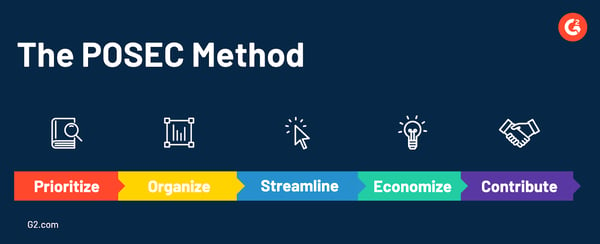
Prioritizing simply means you put the most important things first. That could be as simple as creating a list and ranking your tasks from most to least important, then completing them in that order.
Organizing means you lay out a strategy for how you’re going to complete these tasks. This helps your goals feel more attainable and it makes tasks easier to complete. When you have a strategy for how things get done, they get done faster.
Streamlining focuses on the tasks that you don’t want to do, but need to get done. Cleaning your dishes, folding your laundry, and so on. These are the mundane tasks that can’t be ignored. Streamlining is designed to get them done quicker and more effectively so you can focus on the important tasks at hand.
Economizing refers to tasks that you enjoy doing. These are your hobbies and your leisure activities. While these might be the most fun to do, they’re not needed. You should place these tasks at the bottom of your to-do list.
Contributing includes your social obligations. This can include attending a friend’s party or volunteering at an animal shelter. These tasks include other people relying on you, so they tend to be placed higher on the list than solo projects.
Choosing the right method: Ultimately, you’ll probably need to try more than one of these methods before finding one that works for you. Don’t be afraid to mix and match strategies from all of them and create your own!
People who excel at time management all have one thing in common. It’s not that they’re smarter or naturally gifted, it’s that they’ve created a system that works for them.
There’s no uniform time management strategy that works for everyone. But with the right skills, you can find a way to manage time that works best for you.
Staying organized is the most important skill to have when utilizing time management. This means organizing your schedule, your priorities, your obligations, and more. Find a way to organize all of your most important information in one place.
Once you’ve organized everything it’s time to prioritize your tasks. The most important things should be at the top of your to-do list. Try creating a short-list of three “must-dos” every morning before you leave your house. No matter how hectic things get you can refer to those most vital tasks as your source of what needs to get done.
You’re likely going to run into tasks that need to get done but aren’t a priority — this is where delegation comes in. Whether at work or home, you can delegate these less important tasks to other people. If nobody else is available to do them you can always defer these tasks for later.
Forgetting to schedule downtime for yourself is a huge mistake. Time management encompasses every part of your life, including your Monday night Bachelor watching session! Don’t feel guilty about allowing yourself time to decompress and just chill every once in awhile.
You’re not the only person who needs to be aware of your time management. Your partner, your children, your coworkers, and your friends need to be aware of your strategy. Communicate your boundaries with people and stick firm to them. Don’t let others pressure you into breaking a good habit.
Setting goals for yourself helps you stay accountable. Try starting small by scheduling a few key things to get done each week. Once you’ve got the hang on that, you can focus on longer term goals for yourself. Maybe you want to spend more time reading? Or get more done at work? These are all goals that time management can help you achieve.
The obvious benefit of time management is that you’ll have more time in your day to get things done. But there are other more subtle advantages to managing your time better. These perks can help you immensely in both your personal and professional life.
This one is a no-brainer. When you spend less time focusing on how you’re going to get everything done, your stress levels decrease significantly. Planning and executing your schedule without procrastination gives you more time to do the things you love doing, instead of worrying about how you’re going to do all the things you need to do.
Creating a schedule and executing tasks on a timeline will improve the quality of your work. Knowing what you’re getting done allows you to be fully present in the moment. You don’t have to worry about pre-planning and can focus on completing your work instead.
When you use your time more effectively, you actually get more time back. Those wasted minutes you used to spend checking your phone or avoiding work add up. This means you can take on more projects, new hobbies, or even time to just relax. The world opens up once you take control of your time.
One of the biggest side-effects of poor time management is an unbalanced work and home life. If you find yourself taking work home with you every night there’s a chance you have a problem with wasting time at work.
Better time management at work will free up your personal life. When you stop taking work home with you it can give you more time for your hobbies, your spouse, your children, or your pets. It’s a win-win for every aspect of your life!
Making the most of your time is tricky. There will always be things in your life that you absolutely have to do. Picking your kids up from school, making dinner, and showering are things that take up time that you can’t just stop doing. Making the most of your time is an invaluable skill that can benefit every aspect of your life.
Time blocking is a popular project management strategy where you block off large sections of your calendar every day for a specific activity. Time blocking encourages you to focus on what needs to get done and sets an expectation for when these tasks will be completed. It can be done in your online calendar or even a personal planner.
Here’s an example of what a time blocked schedule looks like compared to an open calendar:

Notice how there are scheduled breaks in-between these large blocks of time? This allows you space to do other things as they come up throughout the day. What makes time blocking great is that it also communicates to other people when you are busy, which lessens the chance for distractions during the day.
You might be shocked to learn this, but multitasking is actually making your time management worse. Some studies report that multitasking can cause projects to take as much as 40% more time to complete than if you’d just focused on a singular task.
Those same studies suggest that only 2.5% of the entire population falls under the category of “supertaskers” who are able to multitask effectively.

If you think you might be one of those supertaskers, you’re probably not. Once again, studies show that people who think they’re great at multitasking are often the worst of us all. You’re better off sticking to one task at a time and finishing it to completion.
Procrastination is one of the toughest parts of time management. It’s very easy to fall into the mindset of “doing things later”. We all know what can happen when you push everything off to do later. You’ll need to face your procrastination head-on if you want to get better at managing your time.
Here are four steps to help you kick your procrastination habit:
Don’t let yourself get into a shame spiral over procrastination. We all do it from time to time. Focus on what you’re doing to overcome the urge to push things off. Create a plan and stick to it. You might be surprised how easy it is to beat procrastination with a little mindfulness!
For many of us, technology falls into the category of distractions. But in some cases, it can actually help you manage your time better.
If you’re looking to manage your personal life better there are tons of time management apps that you can download directly to your phone. These apps range from calendar apps to scheduling tools and more!
For professionals looking to manage their time better there are more than 750 project management software options available on the market. These tools allow you to create workflows, tag teammates in new projects, and track your time more effectively.
Find the best project management software on the market based on real user reviews from people like you.
It’s impossible to manage your time better if you don’t know what you’re using your time for. Spend a full week tracking your day-to-day in a planner or calendar. Write down what you’re doing throughout the day whether it’s eating, napping, or working. Once you have the full picture of how you spend your time, it’s easier to decide what can stay and what can go.
Learning how to say no will save you a lot of trouble. As we mentioned earlier in the Eisenhower Decision Matrix, not everything is worth your time! Be choosier about what projects you commit your time to and which ones you let fall away. Learning to value your time will make managing your schedule much easier.
Perfectionism can be a double-edged sword. Time is often wasted on trying to get the details of a project exactly right, losing valuable time you could use doing something else. You can counteract this by setting a predetermined amount of time to complete a task. If you know you only have an hour to get something done, you’re less likely to waste time on other things.
You know how some people meal prep their entire week of meals on Sunday? You can do the same thing with your time.
Sit down and time block each day of your week every Sunday evening. This sets a schedule you can stick to and frees up time in your schedule. Then, you can spend the first 15 minutes of each day reviewing your time blocks and adjusting for anything that came up since you scheduled things. Planning ahead and adjusting daily will add up to hours saved over time.
Nothing beats a good old-fashioned planner. It’s your lifeline for what’s happening when. Some people prefer to use a physical planner while others go the digital route. No matter which option you choose, a planner will keep you accountable for sticking to the schedule you create for yourself.
One of the biggest reasons people procrastinate is they dread doing a difficult or time-consuming task. You can break this habit by getting those demanding tasks out of the way first.
Once you’re over the hill of your most difficult projects, everything else will seem like a breeze! Plus, it gives you a sense of accomplishment that can boost your energy for the rest of the day.
You don’t have to spend every second of every day on a schedule. It’s important to pencil in time to relax with your family or watch your favorite Netflix show. Try giving yourself one day a week where you don’t schedule anything to do. Let the day take you where it will and just go with the flow. This helps you recharge your batteries and prevent burnout.
There’s a good chance that you’ll encounter someone who tries to derail your time management habits. Whether that’s a coworker or family member, you need to establish firm boundaries with them. This could mean saying no to ineffective or bad meetings, or reminding your spouse that you need time to complete certain tasks. Staying firm in your plan is crucial to your success.
Time tracking software sets allotted dropdowns of listed projects and areas for workers to distribute their work hours, build productivity and manage their pipeline with a relaxed mindset. This is a direct or indirect way of slicing and dicing your KPIs as per the timeline that it has been given to help you steer clear of confusion.
* Below are the top five leading time tracking software from G2’s Spring 2024 Grid® Report. Some reviews may be edited for clarity.
monday.com is platform agnostic work automation platform that synchronizes projects, organizes schedules and sets async project updates through a series of dashboards, automation and agile tools. Employees can automate and build their own time management capsules and automate task updates and alerts to plan their work weeks in an efficient way.
"monday.com is used throughout the various departments to help track of information. monday.com is a great tool for keeping track of items, recording their progress, and conveying statuses and monday.com as a project management tool fou our team members to stay in touch on a specific project. monday.com is great for us because we have several remote working teams. We really like how each member can log in and work on a project at the same time."
- monday.com Review, Shubham J.
'It is quite pricey in Asia. Apps sometimes get slow or even down without notice. And some automation doesn't always execute right. But overall, it's amazing!"
- monday.com Review, Wiwin A.
ClickUp is a popular team productivity and collaboration platform that sets schedules for your daily agendas, standups and scrums. ClickUp enables transparency and visibility into company-wide tasks and updates project members in real-time of the updates and modifications that you make through your platform. It also comes with an embedded gantt chart template to plan and prioritize your projects better.
"The ease of use is absolutely amazing. CllickUp is extremly easy not only to user for all the team. It's also very easy to customize to get the best value out of it. An amazing amount of ClickApps (plugings/addons) and integrations with everything from custom fields, relations/dependencies, calendar, email and other integrations. My top picks will be automations and builtin AI assistance."
- ClickUp Review, Oskar B.
"ClickUp sometimes does not store data that's been entered into fields--example: I can enter a date into a text field but it won't remain there and will default to whatever was there before. It can be frustrating and lead to a sense of unreliability."
- ClickUp Review, Lea M.
Paylocity is a cloud-based HRIS and HRMS management software tool that streamlines your payroll, leave management, attendance management, time tracking, tax compensation, benefits administration and workflow management. It is a one-stop platform for all talent-based operations and staff operations. It is designed to streamli,e corporate administration and workplace culture.
"The tools provided by the software for payroll and HR are very relevant to the tasks required for each discipline and mostly user friendly. Utilizing the PR and HR features allows these tasks to be processed with the knowledge these tasks are completed accuratley and by knowlegeable staff. In short, it allows us to contract out these time consuming tasks with the assurance it is being donw correctly."
- Paylocity Review, Bill N.
"Sometimes communicating issues or questions by email get a little lost and service tickets get worked on and closed without confirming the client (me) is checked in with and understands changes made to show issues or questions were resolved."
- Paylocity Review, Kathleen H.
4. ClickTime
ClickTime is an efficient project planning and time tracking tool that aids in cost reduction by expediting work turnarounds, real-time project visibility and project control and intuitive time management tools and analytical reporting dashboards. Established in 1999, ClickTime now is a public cloud-based collaborative platform to manage your key responsibility areas (KRAs) without any distraction, review performances and organize incremental cycles.
What users like:
Anyone who has to track their time knows how painfully annoying it is. ClickTime makes it relatively painless by providing recent projects and tasks in the entry dropdown. If you haven't logged time to a project recently, you can search for it from the same location, making it fast to log time.
The auto-save feature is amazing because it means you don't lose your work. This is especially important since no one wants to enter time *twice*!"
- ClickTime Review, Shubham J.
"ClickTime mobile app does not work properly, it has a lot of bugs and various other issues. Sometimes it does not auto save the hours that I have inputted."
- ClickTime Review, Gurliv Singh S.
HR one is an cloud based HR productivity platform which enables teams to sync their contact information, ID proofs, pay slips, leave and attendance management, W-9 and 1099 forms, tax and witholdings, and benefits administration from a centralized platform. It automates HR processes, time tracking and provides the best employee experience any HR app could provide.
"HRMS platforms are many but Hrone stand out in all the way. It is a user friendly platform where employees as well as any admin can easily function without any work load . Hrone makes it easy to function in all the fields and also helps in delievring the timely support that is required where it is needed the most . All the modules are addressed and can be easily navigated and understood . Different reports can be fetched in the system which makes work much easier and better for work environment."
- HROne Review, Rahul P.
"While the mobile app is convenient for quick access, some additional features available on the desktop version are not fully integrated, leading to a somewhat limited functionality on mobile devices."
- HROne Review, Tabassum A.
No need for a time machine!
Once you’ve mastered the art of time management, your days of yearning for a time machine will be a thing of the past. You’re in charge of your time. It might take some serious adjusting at first but utilize these tools and you’ll reclaim your time before you know it!
Don't let the troublesome work past come back to haunt you. Learn how to diligently manage your tasks with best task management software in 2024.

Plan your day with actionable timetables and maintain a happy and positive attitude towards work with best time tracking software.
Lauren Pope is a former content marketer at G2. You can find her work featured on CNBC, Yahoo! Finance, the G2 Learning Hub, and other sites. In her free time, Lauren enjoys watching true crime shows and singing karaoke. (she/her/hers)

Plan your day with actionable timetables and maintain a happy and positive attitude towards work with best time tracking software.
No matter how well we try to plan our day, be more productive, and simply get more done, time...
 by Selene Nelson
by Selene Nelson
When a project manager begins work, they want to make sure all steps in the process are...
 by Grace Pinegar
by Grace Pinegar
They say there are two ways to skin a cat (ew), and there are even more ways to manage a...
 by Grace Pinegar
by Grace Pinegar
No matter how well we try to plan our day, be more productive, and simply get more done, time...
 by Selene Nelson
by Selene Nelson
When a project manager begins work, they want to make sure all steps in the process are...
 by Grace Pinegar
by Grace Pinegar
Never miss a post.
Subscribe to keep your fingers on the tech pulse.



